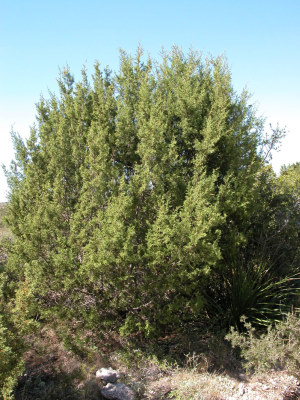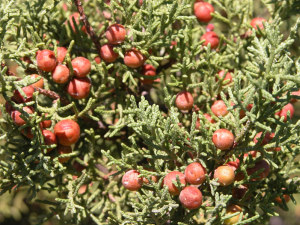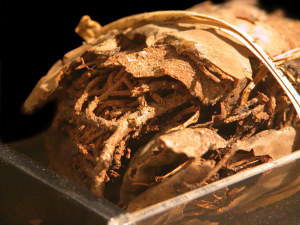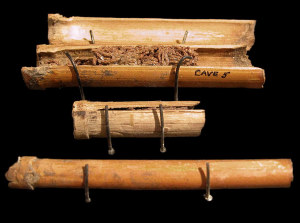Ashe Juniper, Red Berry Juniper
Ashe Juniper (Juniperus asheii Buchh.)
Red Berry Juniper (Juniperus pinchotii Sudw.)
Cupressaceae (Cypress Family)
Juniper is a medium-sized tree and several species grow widely in the region. Its wood and bark was used as fuel and for toolmaking. Its small fruits were eaten and its leaves were used for medicine and ritual. Juniper was a truly useful and important plant for native groups in the Plains and Southwest.
Both Ashe juniper and red berry juniper have overlapping distributions in the western Edwards Plateau and Trans-Pecos regions. The distribution of Ashe juniper is centered on the Edwards Plateau, but its westward limits include the eastern edge of the Trans-Pecos. Junipers are usually dioecious, that is some trees have all male flowers and some trees have all female flowers. Red berry juniper is the most common juniper of the Trans-Pecos (Powell 1998:27). Both species are evergreen trees that grow 18 to 20 feet tall with short trunks and scale-like leaves. The most distinctive difference between the two is the fruit, copper-colored in red berry juniper and blue-green in Ashe juniper.
Widely scattered solitary juniper trees or small stands are present throughout the Amistad Reservoir region. Near the Rio Grande juniper grows mostly near canyon heads, in canyons, or along north-facing slopes of low hills, but within 15-20 miles north of the river juniper is widespread across the uplands. A specimen of Ashe juniper was collected at the Pecos River Gauging station on a rocky slope above the Pecos River (AMIS 41524). A stand of red berry juniper is located in a wide canyon on Zuberbueler Bend within two miles of the Rio Grande.
Because most ethnography was recorded outside of the distributional limits of Ashe juniper, this author has not yet found mention of this plant the ethnobotanical literature. There are a few notes regarding the use of red berry juniper. These plants have much in common with Juniperus monosperma, or one seeded juniper, for which there is much information. Most importantly, the fruit of Ashe and red berry juniper is quite edible, the red berry juniper is especially tasty.
Archeological occurrence. Juniper wood is very workable and useful and provides excellent fuel, and wherever juniper grows the charcoal is recovered from pre-contact period hearths and roasting pits of the Native Americans. Juniper wood was recovered from Early Archaic earth oven at Hinds Cave, and juniper seed was recovered from more recent midden deposits directly above the oven in Block A (Dering 1979). Juniper wood was also noted in burned rock midden deposits at four sites in northern Val Verde County (Dering 2003). It is clear that juniper was utilized by the Native Americans in the region both for its fruit and wood.
Food. As previously noted, there are not many ethnographic references to either red berry or ashe juniper. However, some of the identification in the ethnography is obviously a little sloppy. For example, in the binomial key to the genus, one of the dividing characteristics is whether the cones are fleshy and juicy or dry and fibrous (eg. Correll and Johnston 1970; Powell 1998). Both Ashe juniper and red berry juniper have juicy pulps. Red berry juniper has a very excellent fruit; it is relatively pulpy and sweet, with just a hint of resin. Most ethnographic references discuss red berry juniper only as a medicinal plant, but it actually produces one of the best-tasting juniper "berries" in North America.
Carlson and Jones (1942:522) note that the Comanche ate the cones of the eastern red cedar, but this species has a fibrous cone that is not particularly flavorful. Both Ashe juniper and red berry juniper have a juicier and sweeter fruit, and grow in an overlapping distribution with eastern red cedar, at least in western Oklahoma. They would have been known to the Comanche and would have been readily consumed along with the less edible eastern red cedar in that part of Comanche territory.
One-seeded juniper, Juniperus monosperma, for which many ethnographic references are available, grows in an overlapping distribution with red berry juniper, and both have a juicy cone. Unfortunately, in the area of northern New Mexico and Arizona where most of the ethnographic observations were recorded, red berry juniper does not grow. However, the fruit has a similar taste and texture to one-seeded juniper. The primary difference is that one-seeded juniper cones are blue-green and red-berry juniper cones are copper-colored. For this reason, some of the uses of one-seeded juniper are mentioned.
One-seeded juniper berries were consumed by the Keresan (White 1945:561; Elmore 1944:19) Ramah Navajo (Vestal 1952:11), Tewa, Tewa at Hano, and at San Idelfonso (Robbins et al 1916:40). The Chiricahua/Mescalero and the White Mountain Apache cooked the fruit into a soup or gravy (Castetter and Opler 1936:45; Reagan 1929:158). Many groups cooked meat with the juniper berries, including the Keres, the Hopi, and the Acoma, who chopped meat with the fruits and placed the combination in a deer stomach before roasting it (Castetter 1935:31).
Medicine and ritual. In the Southwest the most cited juniper in ethnography is the one-seeded juniper. White Mountain Apache used an Infusion of leaves taken for colds and coughs (Reagan 1929:158). Decoctions or infusions of the leaves were taken by the Ramah Navajo and Tewa for a variety of illnesses, including postpartum pains, burns, coughs, or stomach aches (Robbins et al. 1916:39-40; Vestal 1952:11-12). The Tewa heated boughs and applied them to sprained or arthritic limbs (Robbins et al. 1916:39). The Zuni used juniper boughs or leaves during childbirth, applying infusions or decoctions to promote relaxation of muscles during birth or to stop flow of blood after birth (Stevenson 1915: 55).
Many groups in the Southwest and the Plains used juniper for ceremonial purposes. Plains Indians used juniper leaves (primarily eastern red cedar) were widely used for ceremonial purposes. The Comanche placed juniper leaves on a fire and inhaled the smoke for purification (Carlson and Jones 1942:522). The Omaha linked cedar (juniper) to thunder, lightning, and wars, and used juniper boughs for incense, placing it on hot stones in a vapor bath in purification rites (Gilmore 1913:323). The Osage used the twigs and incense and considered juniper a tree of life --- "it is always green, is durable, pleasing to the eye, the gift of God (Gilmore 1913:321)."
Cane tubes filled with juniper leaves were recovered from Shumla Caves. It is clear from this discovery that juniper played a similar part in healing and ceremonial practices that it did in the adjacent Great Plains and desert Southwest of North America.
References:
Castetter, Edward F.
1935 Uncultivated Native Plants Used as Sources of Food. Ethnobiological Studies in the American Southwest. Vol. I. The University of New Mexico Bulletin, Biological Series 4(1). Albuquerque, New Mexico.
Correll, Donovan S. and Marshall C. Johnston
1970 Manual of the Vascular Plants of Texas. Contributions from the Texas Research Foundation, Volume 6. Renner, Texas.
Dering, J. Philip
1979 Pollen and Plant Macrofossil Vegetation Record Recovered from Hinds Cave, Val Verde County, Texas. Masters Thesis, published by the Department of Anthropology. Texas A&M University, College Station, Texas.
2003 Plant Remainsfrom U.S. Highway 277 Project, Val Verde County, Texas. In Archeological Data Recovery Investigations of Four Burned Rock Midden sites (41VV1892, 41VV1893, 41VV1895, 41VV1897), Val Verde County, Texas, by Cliff, Maynard, pp. A1-A13. PBS&J. Doc. 10102, Texas Department of Transportation Archeological Studies Program Report No. 51. Austin, Texas.
Elmore, Francis H.
1944 Ethnobotany of the Navajo. University of New Mexico Bulletin. Monograph Series 1(7). University of New Mexico Press, Albuquerque, New Mexico.
Gilmore, Melvin
1913 A study in the Ethnobotany of the Omaha Indians. Collections of the Nebraska State Historical Society 17:314-357.
Robbins, Wilfred Wiliam, John Peabody Harrington and Barbara Freire-Marreco
1916 Ethnobotany of the Tewa Indians. Bureau of American Ethnology Bulletin 55. Smithsonian Institution, Washington, D.C.
Stevenson, Matilda Coxe
1915 Ethnobotany of the Zuni Indians. In Thirtieth Annual Report of the Bureau of American Ethnology, [1908-1909], pp. 35-103. Washington, D.C.
Vestal, Paul
1952 Ethnobotany of the Ramah Navaho. Papers of the Peabody Museum of American Archaeology and Ethnology 40 (4). Harvard University. Boston, Massachusetts.
White, Leslie A.
1945 Notes on the Ethnobotany of the Keres. Papers of the Michigan Academy of Arts, Sciences and Letters 30:557-568.
![]()



